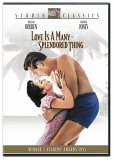Synopsis
The year is 1949, and mainland China is falling to the Communists. Eruasian doctor HanSuyin (Jennifer Jones, and the casting should be a bit of a clue as to what you’re in for) has asuccessful professional life in Hong Kong, but her personal life has been nonexistent since thedeath of her husband. Then reporter Mark Elliot (William Holden) waltzes into her life, refusingto take no for an answer. Of course, their love is beset by all sorts of obstacles, be it racialsuspicio… on both sides of society, the fact that Holden’s wife won’t grant him a divorce, anda little something called the Korean War. This 1955 melodrama hasn’t aged particularly well,and much of the dialogue (“Now we will have tea and talk of absurdities.”) is utterly risible.Jones’ primary method of expressing happiness is to spin around, hug herself and face the sky(see back of case for a case in point). Various plot threads are introduced, but never followedup, and the whole project takes itself so deeply seriously that you can’t. Rather fun for campvalue, however.
Audio
The sound is in 4.0, and I’m not sure the mix was an entirely wise idea. The sound is clean,in that there is none of the rear-speaker static that plagues so many mono conversions. However,the effect on the dialogue borders on the disastrous. The voices not only are in surround, theypop in and out of surround randomly, and the effect is most distracting. The sound effects aren’t,bad, but they are also undifferentiated, playing at almost equal volume from all speakers. Themusic (the Oscar-winning theme, repeated until you’re half mad) is the element best served bythe mix.
Video
The full 2.55:1 Cinemascope ratio is preserved in the transfer, which is nice for the widepanoramas that punctuate the big romantic moments. The print, thanks to the restoration, is invery nice shape, with only a few moments of speckling at about the 65 and 90 minute marks.There is some flicker, however, of varying degrees, but sometimes quite noticeable. The oddesttick is due to the restoration. According the Restoration Comparison feature, the transitions werebetter preserved than the rest of the film, and an effort was made to bring the bulk of the movieup to snuff. Though the effort is largely successful (the colours look great, and grain is noticeablein only a few exteriors), where the two prints have been linked is easy to spot: a single flickeroccurs immediately before and after almost every transition.
Special Features
As with the other films in the Studio Classics series, the commentary is first-rate. Here theparticipants are three film historians: Sylvia Stoddard (whose focus is the film itself and itscontext in both film and world history), Michael Lonzo (who deals, in very technical detail, withthe cinematography), and John Burlingame (who talks about the music). Also included as theA&E Biography episode on William Holden, a couple of newsreel clips showing the filmwinning awards (“Audience Awards” — which seem to be the ancestors of the People’s ChoiceAwards — and “Photoplay Awards”), the aforementioned Restoration Comparison, and thearicaltrailers for Love is a Many-Splendored Thing (quite grainy) and the other Studio Classics. Themenu is basic.
Closing Thoughts
You’re far more likely to laugh than weep. The movie is not in the same league as most ofthe other films in the Studio Classics series, but is not without its amusements, and thecommentary is very strong.
Special Features List
- Audio Commentary
- A&E Biography: “William Holden: An Untamed Spirit”
- Movietone Newsreel Clips
- Theatrical Trailers
- Restoration Comparison




